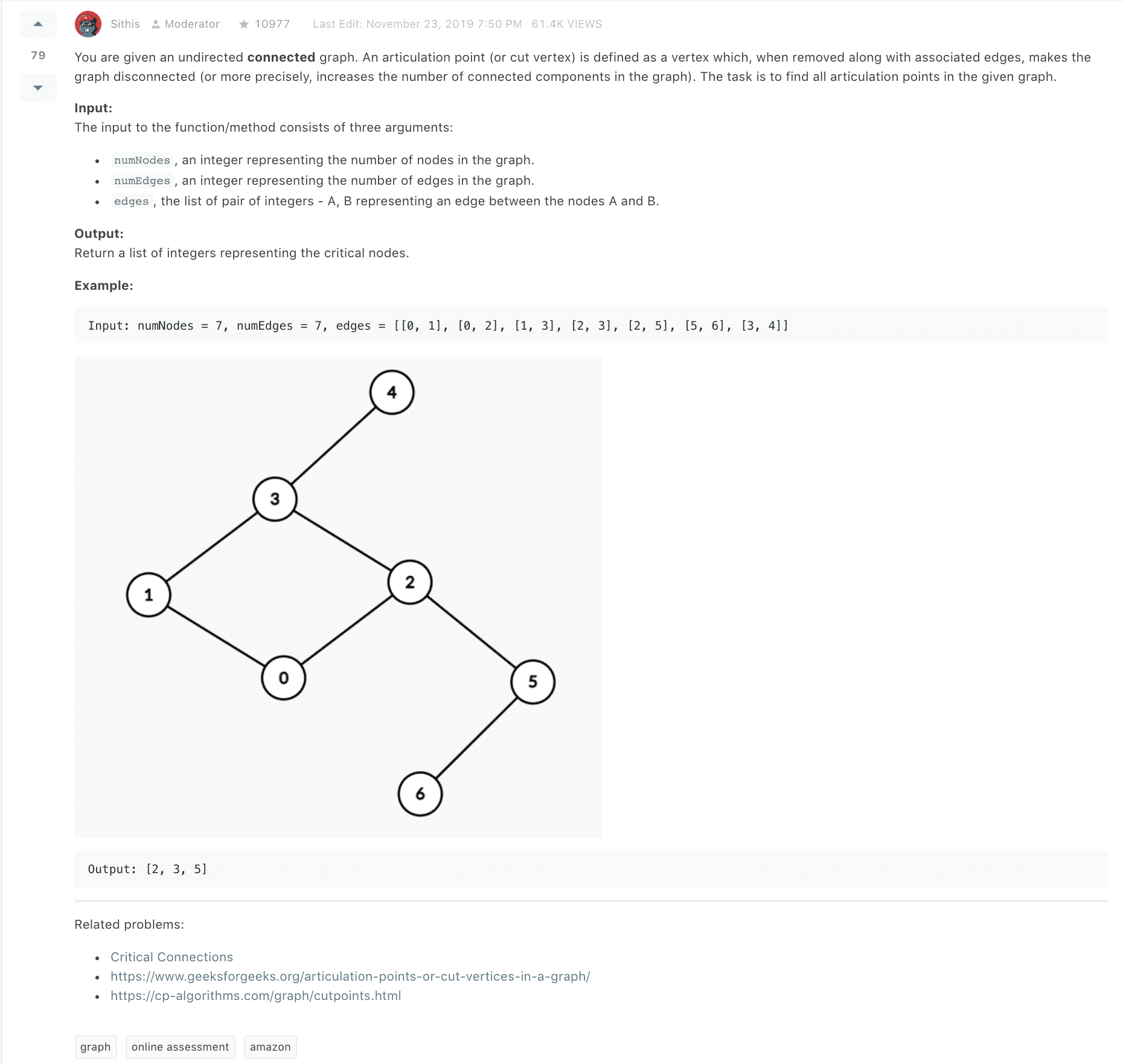
REF. Connected Components in an undirected graph1
2
3
4
5
6
7
8
9
10
11
12
13
14
15
16
17
18
19
20
21
22
23
24
25
26
27
28
29
30
31
32
33
34
35
36
37
38
39
40
41
42
43
44
45
46
47
48
49
50
51
52
53
54
55
56
57
58
59
60
61
62
63
64
65
66
67
68
69
70
71
72
73
74import java.util.*;
class Graph {
int V;
LinkedList<Integer>[] adjListArray;
Graph(int V) {
this.V = V;
adjListArray = new LinkedList[V];
for (int i = 0; i < V; i++) {
adjListArray[i] = new LinkedList<Integer>();
}
}
void addEdge(int src, int dest) {
adjListArray[src].add(dest);
adjListArray[dest].add(src);
}
void DFSUtil(int v, boolean[] visited) {
visited[v] = true;
// System.out.print(v + " ");
for (int x : adjListArray[v]) {
if (!visited[x]) DFSUtil(x, visited);
}
}
int connectedComponents(int exclode, boolean sign) {
int num=0;
boolean[] visited = new boolean[V];
for (int v = 0; v < V; ++v) {
if (!sign&&!visited[v]) {
DFSUtil(v, visited);
num++;
}else if(sign&&v!=exclode&&!visited[v]){
DFSUtil(v, visited);
num++;
}
}
return num;
}
}
public class MyClass {
public static void main(String[] args) {
int numNodes = 7;
int[][] edges= {{0, 1}, {0, 2}, {1, 3}, {2, 3}, {2, 5}, {5, 6}, {3, 4}};
Graph g = new Graph(numNodes);
for(int[] edge:edges){
g.addEdge(edge[0], edge[1]);
}
int beforeNum=g.connectedComponents(-1,false);
System.out.println("connected components numbers: "+beforeNum+"\n");
List<Integer> res=new ArrayList<>();
for(int i=0;i<numNodes;i++){
LinkedList<Integer> neighbors=g.adjListArray[i];
for(int neighbor:neighbors){
g.adjListArray[neighbor].remove((Object)i);
}
int afterNum=g.connectedComponents(i,true);
System.out.println("connected components numbers: "+afterNum);
if(afterNum>beforeNum) res.add(i);
for(int neighbor:neighbors){
g.adjListArray[neighbor].add(i);
}
}
System.out.println(res);
}
}

1
2
3
4
5
6
7
8
9
10
11
12
13
14
15
16
17
18
19
20
21
22
23
24
25
26
27
28
29
30
31
32
33
34
35
36
37
38
39
40
41
42
43
44
45
46
47
48
49
50
51
52
53
54
55
56
57
58/*
A simple brute force solution,
for every vertex, remove the corresponding edges and perform dfs.
If total vertices traversed in dfs != numNodes-1,
then the current removed vertex is a critical router.
*/
/*
class CriticalRouter {
public List<Integer> getCriticalRouters(int numNodes, int numEdges, int[][] edges) {
// construct graph
Map<Integer, Set<Integer>> graph = new HashMap<>();
// initialize graph
for (int i = 0; i < numNodes; i++) graph.put(i, new HashSet<>());
// add edges to graph
for (int[] edge : edges) {
int u = edge[0];
int v = edge[1];
graph.get(u).add(v);
graph.get(v).add(u);
}
List<Integer> result = new ArrayList<>();
// calculate critical routers
for (int nodeToRemove = 0; nodeToRemove < numNodes; nodeToRemove++) {
// remove each node and its edges and check if entire graph is connected
Set<Integer> nodeEdges = graph.get(nodeToRemove);
int source = 0;
for (int edge : nodeEdges) {
graph.get(edge).remove(nodeToRemove);
source = edge;
}
HashSet<Integer> visited = new HashSet<>();
dfs(graph, source, visited);
if (visited.size() != numNodes - 1) {
// this node was a critical router
result.add(nodeToRemove);
}
// add the edges back
for (int edge : nodeEdges) graph.get(edge).add(nodeToRemove);
}
return result;
}
public void dfs(Map<Integer, Set<Integer>> graph, int source, Set<Integer> visited) {
if(visited.contains(source)) return;
visited.add(source);
for (int child : graph.get(source)) dfs(graph, child, visited);
}
}*/
